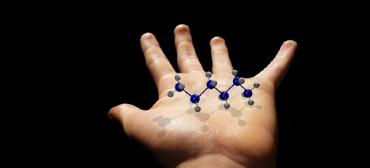Juvenile Ankylosing Spondylitis
What is juvenile ankylosing spondylitis?
Juvenile ankylosing spondylitis (JAS) is a type of arthritis that affects the spine and the sites where the muscles, tendons, and ligaments are attached to bone. "Ankylosing" means stiff or rigid, "spondyl" means spine, and "itis" refers to inflammation. The disease causes inflammation of the spine and large joints, resulting in stiffness and pain. The disease may result in erosion at the joint between the spine and the hip bone (the sacroiliac joint), and the formation of bony bridges between vertebrae in the spine, fusing those bones. In addition, bones in the chest may fuse.
JAS is considered to be a multifactorial condition. Multifactorial inheritance means that "many factors" are involved in causing a health problem. The factors are usually both genetic and environmental, where a combination of genes from both parents, in addition to unknown environmental factors, produce the trait or condition. Often one gender (either males or females) is affected more frequently than the other in multifactorial traits. Multifactorial traits do recur in families because they are partly caused by genes.
A group of genes on chromosome 6 code for HLA antigens play a major role in susceptibility and resistance to disease. Specific HLA antigens influence the development of many common disorders. Some of these disorders, such as JAS, are autoimmune related and inherited in a multifactorial manner. When a child has a specific HLA antigen type associated with the disease, he/she is thought to have an increased chance to develop the disorder. The HLA antigen associated with JAS is called B27. Children with the B27 HLA antigen are thought to have an increased chance (or "genetic susceptibility") to develop JAS; however, it is important to understand that a child without this antigen may also develop JAS. This means HLA antigen testing is not diagnostic or accurate for prediction of the condition. Males are affected with JAS three times more often than females.
JAS is one of four disorders which are classified as spondyloarthropathies. The other disorders are psoriatic arthritis, inflammatory bowel disease, and Reiter's syndrome. These disorders have similar features such as:
-
Inflammation of the spine and sacroiliac joints
-
Family history of the disease
-
Similar nonarthritis symptoms
-
Absence of rheumatoid factor (RF) in the blood (an antibody found in the blood of most, but not all, people who have rheumatoid arthritis, as well as other rheumatic diseases)
Who is affected by juvenile ankylosing spondylitis?
AS strikes young people, typically between ages 17 and 35, but it also may affect adolescents. AS is thought to affect males two to three times more often than it does females.
What are the symptoms of juvenile ankylosing spondylitis?
Symptoms of JAS tend to occur and disappear over periods of time. The following are the most common symptoms of JAS. However, each child may experience symptoms differently. Symptoms may include:
-
Back pain, usually most severe at night during rest
-
Early morning stiffness
-
Stooped posture in response to back pain (bending forward tends to relieve the pain)
-
Inability to take a deep breath, if the joints between the ribs and spine are affected
-
Appetite loss
-
Weight loss
-
Fatigue
-
Fever
-
Anemia
-
Pain at the site of attachment of muscles, ligaments, and/or tendons to bone (enthesitis)
-
Joint pain, particularly in the legs
-
Vague pain, usually in the buttocks, thighs, heels, or near the shoulders
-
Eye inflammation that is painful and causes redness and light sensitivity; may have frequent recurrences of eye inflammation
-
Organ damage, such as the heart, lungs, and eyes
Symptoms of juvenile ankylosing spondylitis may resemble other medical conditions or problems. Always consult your child's physician for a diagnosis.
How is juvenile ankylosing spondylitis diagnosed?
In addition to a complete medical history and physical examination, diagnostic procedures for juvenile ankylosing spondylitis may include:
-
X-rays--a diagnostic test which uses invisible electromagnetic energy beams to produce images of internal tissues, bones, and organs onto film.
-
Erythrocyte sedimentation rate (ESR or sed rate)--a measurement of how quickly red blood cells fall to the bottom of a test tube. When swelling and inflammation are present, the blood's proteins clump together and become heavier than normal. Thus, when measured, they fall and settle faster at the bottom of the test tube. Generally, the faster the blood cells fall, the more severe the inflammation. (People with JAS often have an elevated ESR.)
-
Detection of (HLA-B27) antigen--HLA-B27 is an antigen (a substance that causes the body to produce antibodies to fight bacteria, viruses, and other "foreign" particles to prevent infection) whose presence may indicate the presence of some type of autoimmune disease (a condition in which the body's own defenses begin to attack the body's cells).
Treatment for juvenile ankylosing spondylitis
The goal of treatment for JAS is to reduce pain and stiffness, prevent deformities, and help your child maintain as normal and active a lifestyle as possible.
Specific treatment for juvenile ankylosing spondylitis will be determined by your child's physician based on:
-
Your child's overall health and medical history
-
Extent of the condition
-
Your child's tolerance for specific medications, procedures, and therapies
-
Expectation for the course of the disease
-
Your opinion or preference
Treatment may include:
-
Nonsteroidal anti-inflammatory medication, NSAIDs, (to reduce pain and inflammation)
-
Short-term use of corticosteroids (to reduce inflammation)
-
Disease modifying antirheumatic drugs (DMARDS), such as methotrexate or biologics, such as infliximab or etanercept, which are designed to interfere with your body's inflammatory response
-
Maintain proper posture
-
Regular exercise, including exercises that strengthen back muscles
-
Physical therapy
Related Questions
Expert advice from physician
- 3655 Days ago
- Bones, Muscles and Joints
Acl surgery
- 3688 Days ago
- Arthritis - Bones, Muscles and Joints
Presura on vain
- 3690 Days ago
- Osteoporosis - Bones, Muscles and Joints
Leg muscles
- 3752 Days ago
- Osteoporosis - Bones, Muscles and Joints





















